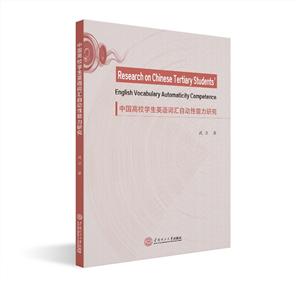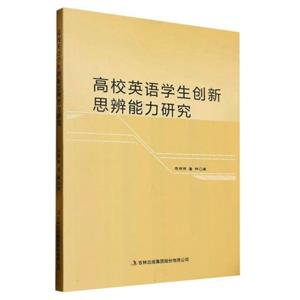
作者:武卫
页数:167页
出版社:华南理工大学出版社
出版日期:2018
ISBN:9787562357391
电子书格式:pdf/epub/txt
内容简介
作者使用多种测试的研究方式, 使用加速和自动性的区分法, 结合正确率数据来测量词汇自动性能力, 为今后的词汇自动性研究提供了新的思路。本书对二语词汇习得能力的理论建设、词汇自动性研究的研究方法和教学实践具有一定的启示意义。
目录
Chapter 1 Introduction
1.1 Preamble
1.2 Objectives of the Research
1.3 Significances of the Research
1.4 Structure of the Book
Chapter 2 Literature Review
2.1 Introduction
2.2 Origins, Features and Definitions
2.3 Models to Account for Automaticity
2.4 Measures of Automaticity
2.5 Automaticity Research in SLA
Chapter 3 Theoretical Framework
3.1 Introduction
3.2 Conceptual Framework of L2 Vocabulary Competence
3.3 Conceptual Framework of L2 Vocabulary Automaticity Competence
3.4 Conceptual Framework of Testing Vocabulary Automaticity Competence
3.5 Conceptual Framework of Major Factors Affecting Vocabulary Automaticity Competence
Chapter 4 Research Design
4.1 Introduction
4.2 Definition and Operational Definitions of Automaticity in the Research
4.3 Research Questions and Hypotheses
4.4 Research Method
4.5 Research Outline
Chapter 5 Experiment 1: Visual Receptive Automaticity Competence in Isolation
5.1 Research Aims
5.2 Participants
5.3 Testing Task and Materials
5.4 Testing Procedure
5.5 Scoring and Data Cleaning
5.6 Results and Discussion
Chapter 6 Experiment 2: Visual Receptive Automaticity Competence in Context
6.1 Research Aims
6.2 Participants
6.3 Testing Task and Materials
6.4 Testing Procedure
6.5 Results and Discussion
Chapter 7 Experiment 3: Productive Automaticity Competence in Isolation
7.1 Research Aims
7.2 Participants
7.3 Testing Task and Materials
7.4 Testing Procedure
7.5 Results and Discussion
Chapter 8 Experiment 4: Productive Automaticity Competence in Context
8.1 Research Aims
8.2 Participants
8.3 Testing Task and Materials
8.4 Testing Procedure
8.5 Results and Discussion
Chapter 9 Experiment 5: Auditory Receptive Automaticity Competence in Isolation
9.1 Research Aims
9.2 Participants
9.3 Testing Task and Materials
9.4 Testing Procedure
9.5 Results and Discussion
Chapter 10 Experiment 6: Auditory Receptive Automaticity Competence in Context
10.1 Research Aims
10.2 Participants
10.3 Testing Task and Materials
10.4 Testing Procedure
10.5 Results and Discussion
Chapter 11 Vocabulary Automaticity Competence in Different Experiment Conditions
11 1 Research Aims
11.2 Results and Discussion
Chapter 12 General Discussion
12.1 Introduction
12.2 Vocabulary Automaticity Competence Achieved
12.3 Effects of Frequency and Proficiency
12.4 Correlation Between Accuracy and Recognition or Retrieval Speed
12.5 Vocabulary Automaticity Competence in Different Experiment Conditions
Chapter 13 Establishing a Model of Vocabulary Automatieity Competence
13.1 Introduction
13.2 The Importance of Building a Model of Vocabulary Automaticity Competence ..,
13.3 The Dimensions of Vocabulary Automaticity Competence
13.4 The Relationships Among the Dimensions
13.5 Vocabulary Automaticity Competence Development Along Four Routes
Chapter 14 Conclusions
14.1 Introduction
14.2 Conclusions
14.3 Theoretical and Methodological Implications
14.4 Pedagogical Implications
14.5 Limitations and Future Directions
Bibliography
Appendices
Appendix 1 Visual Lexical Decision Task (Experiment 1 )
Appendix 2 Visual Sentence Decision Task ( Experiment 2)
Appendix 3 Written Productive Translation Task (WPTT) (Experiment 3)
Appendix 4 The Controlled-production Vocabulary Experiment (Experiment 4)
Appendix 5 Auditory Lexical Decision Task (Experiment 5)
Appendix 6 Auditory Sentence Decision Task ( Experiment 6)
1.1 Preamble
1.2 Objectives of the Research
1.3 Significances of the Research
1.4 Structure of the Book
Chapter 2 Literature Review
2.1 Introduction
2.2 Origins, Features and Definitions
2.3 Models to Account for Automaticity
2.4 Measures of Automaticity
2.5 Automaticity Research in SLA
Chapter 3 Theoretical Framework
3.1 Introduction
3.2 Conceptual Framework of L2 Vocabulary Competence
3.3 Conceptual Framework of L2 Vocabulary Automaticity Competence
3.4 Conceptual Framework of Testing Vocabulary Automaticity Competence
3.5 Conceptual Framework of Major Factors Affecting Vocabulary Automaticity Competence
Chapter 4 Research Design
4.1 Introduction
4.2 Definition and Operational Definitions of Automaticity in the Research
4.3 Research Questions and Hypotheses
4.4 Research Method
4.5 Research Outline
Chapter 5 Experiment 1: Visual Receptive Automaticity Competence in Isolation
5.1 Research Aims
5.2 Participants
5.3 Testing Task and Materials
5.4 Testing Procedure
5.5 Scoring and Data Cleaning
5.6 Results and Discussion
Chapter 6 Experiment 2: Visual Receptive Automaticity Competence in Context
6.1 Research Aims
6.2 Participants
6.3 Testing Task and Materials
6.4 Testing Procedure
6.5 Results and Discussion
Chapter 7 Experiment 3: Productive Automaticity Competence in Isolation
7.1 Research Aims
7.2 Participants
7.3 Testing Task and Materials
7.4 Testing Procedure
7.5 Results and Discussion
Chapter 8 Experiment 4: Productive Automaticity Competence in Context
8.1 Research Aims
8.2 Participants
8.3 Testing Task and Materials
8.4 Testing Procedure
8.5 Results and Discussion
Chapter 9 Experiment 5: Auditory Receptive Automaticity Competence in Isolation
9.1 Research Aims
9.2 Participants
9.3 Testing Task and Materials
9.4 Testing Procedure
9.5 Results and Discussion
Chapter 10 Experiment 6: Auditory Receptive Automaticity Competence in Context
10.1 Research Aims
10.2 Participants
10.3 Testing Task and Materials
10.4 Testing Procedure
10.5 Results and Discussion
Chapter 11 Vocabulary Automaticity Competence in Different Experiment Conditions
11 1 Research Aims
11.2 Results and Discussion
Chapter 12 General Discussion
12.1 Introduction
12.2 Vocabulary Automaticity Competence Achieved
12.3 Effects of Frequency and Proficiency
12.4 Correlation Between Accuracy and Recognition or Retrieval Speed
12.5 Vocabulary Automaticity Competence in Different Experiment Conditions
Chapter 13 Establishing a Model of Vocabulary Automatieity Competence
13.1 Introduction
13.2 The Importance of Building a Model of Vocabulary Automaticity Competence ..,
13.3 The Dimensions of Vocabulary Automaticity Competence
13.4 The Relationships Among the Dimensions
13.5 Vocabulary Automaticity Competence Development Along Four Routes
Chapter 14 Conclusions
14.1 Introduction
14.2 Conclusions
14.3 Theoretical and Methodological Implications
14.4 Pedagogical Implications
14.5 Limitations and Future Directions
Bibliography
Appendices
Appendix 1 Visual Lexical Decision Task (Experiment 1 )
Appendix 2 Visual Sentence Decision Task ( Experiment 2)
Appendix 3 Written Productive Translation Task (WPTT) (Experiment 3)
Appendix 4 The Controlled-production Vocabulary Experiment (Experiment 4)
Appendix 5 Auditory Lexical Decision Task (Experiment 5)
Appendix 6 Auditory Sentence Decision Task ( Experiment 6)














